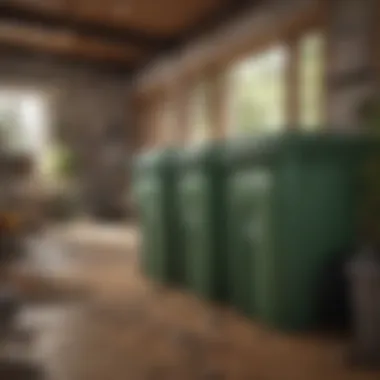Waste Management Strategies for Spring Cleaning


Overview of the Topic
Prelude to Waste Management During Spring Cleaning
Spring cleaning is not just a seasonal ritual; it is an opportunity to reflect on our consumption habits and the waste we generate. Engaging in cleaning projects fosters awareness of environmental impacts associated with clutter accumulation and waste disposal. Excessive waste contributes to landfill overflow, pollutant release, and resource depletion. Therefore, combining spring cleaning with an effective waste management strategy is essential. This article provides insight into practical measures that promote sustainability while decluttering our living spaces.
Background Information on the Significance of the Topic
As people around the globe engage in spring cleaning, it becomes crucial to consider the ecological footprint of these activities. Over the years, waste management has advanced significantly as society grows more aware of environmental concerns. Understanding the principles of sustainable practices during spring cleaning aligns individual actions with broader conservation efforts. Additionally, these practices can facilitate the reduction of waste sent to landfills, minimize resource usage, and encourage a recycling mindset.
Current Status and Challenges
Current State of Waste Management During Spring Cleaning
Waste management practices vary widely across regions. Some locales have well-established recycling programs and composting facilities, while others lack essential infrastructure. Spring cleaning often results in significant waste generation, leading to increased pressure on existing waste management systems. Many individuals do not feel equipped with enough knowledge about suitable disposal methods, often leading them to improper waste disposal.
Challenges Facing Sustainable Cleaning Practices
Challenges are prevalent when implementing effective waste management in the context of spring cleaning. The most significant obstacles include:
- Public Awareness: Many people are not fully aware of their role in sustainable waste management.
- Accessibility: Resources like recycling or compost bins may not always be readily available.
- Inconsistent Policies: Different cities and regions may have varying waste disposal policies, creating confusion for residents.
Sustainable Solutions
Exploration of Sustainable Practices
Adopting sustainable practices during spring cleaning can dramatically reduce waste. Some effective strategies include:
- Decluttering: Focus on keeping only essential items. This not only declutters physical space but also reduces future waste.
- Donation: Items in good condition should be donated to local charities. This helps others in need while keeping items out of the landfill.
- Responsible Disposal: Familiarize oneself with local disposal guidelines. Materials like electronics, batteries, or chemicals often require special handling.
Successful Case Studies
Several communities have implemented innovative waste management strategies during spring cleaning. For example, Boulder, Colorado, launched a program encouraging residents to sort waste at home through a clearly designated recycling and composting system. This initiative led to a substantial increase in materials diverted from landfills.
Impact and Importance
Analysis of the Impact on Ecosystems and Communities
The cumulative effect of individual eco-conscious choices during spring cleaning can be significant. Reducing waste not only preserves natural resources but also minimizes greenhouse gas emissions. Communities that engage in sustainable cleaning practices often foster stronger connections and increase environmental awareness among their members.
Emphasizing Conservation Efforts
Conservation is about safeguarding our environment for today and for future generations. By being mindful of waste management during spring cleaning, each person contributes to sustainability efforts, ensuring healthier ecosystems for tomorrow. Adoption of sustainable habits helps create a culture that prioritizes environmental responsibility in everyday activities.
"Individual actions, when multiplied by millions of people, can transform the world."
Encouraging sustainable practices during spring cleaning leads to lasting benefits. Increased awareness and engagement culminate in a more sustainable way of living, ultimately supporting a healthier planet.
Understanding Waste Management
Waste management is a crucial aspect of maintaining environmental sustainability, especially during spring cleaning. It involves processes that aim to reduce waste, recycle materials, and dispose of items properly. Understanding waste management helps individuals and families make informed choices as they declutter their living spaces. This article will analyze strategies that align with waste management principles while promoting sustainable practices.
Definition and Importance
Waste management refers to the collection, treatment, and disposal of waste materials. Its importance lies not only in keeping environments clean but also in minimizing the adverse effects on health and the planet. Efficient waste management can reduce landfill growth, lower greenhouse gas emissions, and encourage the recycling of valuable materials. For spring cleaning, a solid grasp of waste management can lead to a more sustainable method of handling the often vast amount of waste generated during this time.
Waste Hierarchy Explained
The waste hierarchy is a framework that prioritizes waste management options based on their environmental impact. It typically consists of five key steps: prevention, reduction, reuse, recycling, and disposal. Each component contributes to a holistic approach to waste management, particularly during spring cleaning, where people often reassess their belongings.
Prevention
The concept of prevention involves avoiding waste generation in the first place. This strategy is critical because it directly contributes to minimizing waste output. Preventive measures can include purchasing higher quality items that last longer, or opting for digital documents instead of paper. The key characteristic of prevention is its proactiveness in addressing waste.
The unique feature of this approach is its effectiveness at the source. This can save individuals from the time and effort of later disposal methods. However, it requires a shift in mindset and habits, making it less practical for some.
Reduction
Reduction focuses on consuming less and managing resources efficiently. This can mean buying fewer items or choosing products with less packaging. The major benefit of reduction is its immediate impact on decreasing the amount of waste produced.
Reduction not only lowers waste but also can save money. A challenge, however, can be the initial resistance to change habitual shopping patterns or lifestyles. Changes in behavior can take time to establish.
Reuse
Reuse encourages the use of items multiple times or for new purposes rather than simply discarding them. This practice is beneficial because it extends the life of products and reduces demand for new materials.
Items like glass jars or old clothes serve as common candidates for reuse. However, while this strategy has many advantages, the challenge lies in finding practical applications for reusing items, which can sometimes require creativity and space.
Recycling
Recycling involves processing materials into new products, thereby diverting them from landfills. It is a widely accepted strategy that plays a crucial role in waste management. A key advantage of recycling is that it conserves resources, reduces energy use, and lowers greenhouse gas emissions.
However, to recycle effectively, individuals must adhere to local recycling guidelines, which can vary greatly. The complexity of sorting materials also poses a challenge, leading some to forgo recycling altogether.


Disposal
Disposal should be considered a last resort when no other viable options exist. This aspect of the waste hierarchy involves managing waste that cannot be prevented, reduced, reused, or recycled. Proper disposal methods, such as using designated waste facilities, are essential to mitigate environmental harm.
The key characteristic of disposal is its inevitability in any waste management plan. Nonetheless, reliance on disposal systems can inadvertently reinforce wasteful habits, making it less favorable in the context of sustainable practices.
In summary, understanding the waste hierarchy allows individuals to prioritize their actions during spring cleaning. By incorporating prevention, reduction, reuse, recycling, and responsible disposal into their routines, they can significantly enhance their waste management practices.
The Significance of Spring Cleaning
Spring cleaning holds a unique place in both cultural and practical realms. It is not simply a seasonal chore; it is a profound ritual that signifies renewal and rejuvenation. This practice allows individuals to clear space both physically and mentally, preparing their homes for the year ahead. Understanding the significance of spring cleaning can emphasize the need for effective waste management strategies.
Cultural and Practical Definitions
At its core, spring cleaning is rooted in various cultural traditions. Many societies have engaged in the act of deep cleaning during the spring season for centuries. For some, it marks the end of winter and the arrival of warmer weather. In practical terms, spring cleaning involves a thorough organization and cleansing of living spaces. This often includes a detailed review of belongings, identifying items that no longer serve a purpose. The act of cleaning is not just about physical space; it reflects a mindset aimed at improvement and efficiency.
Health Benefits of Decluttering
Decluttering during spring cleaning goes beyond achieving a tidy home. It has tangible health benefits as well. A clean and organized environment can significantly enhance mental clarity and reduce stress levels. Studies suggest that clutter can contribute to anxiety and contribute to a chaotic atmosphere. Thus, engaging in decluttering can promote a more serene home and life. Moreover, disposing of or donating unwanted items can lead to improved air quality. Dust buildup can be reduced through thorough cleaning, ultimately resulting in a healthier living space.
"A tidy space can lead to a tidy mind, proving that the benefits of decluttering span beyond mere organization."
In summary, spring cleaning is an essential practice that intertwines cultural significance with practical health benefits. It allows individuals to evaluate their possessions critically, promote mental well-being, and engage in sustainable waste management practices.
Decluttering Strategies
Decluttering is integral to waste management, particularly during the spring cleaning season. The act of decluttering not only refreshes a space but also sharpens an individual's focus on what is genuinely needed versus what may be excess. This assessment can lead to significant reductions in waste, contributing to a more sustainable lifestyle. By implementing effective decluttering strategies, individuals can streamline their belongings. This can facilitate easier disposal of waste and enhance overall organization in the home.
Effective Methods for Decluttering
There are various methods for decluttering a space, each offering unique benefits. Below are three effective strategies that homeowners can adopt to minimize waste during their spring cleaning efforts.
The Four-Box Method
The Four-Box Method encourages a systematic approach to decluttering. This method involves using four distinct boxes labeled: "Keep," "Donate," "Recycle," and "Trash." The simplicity of this method is one of its strengths. It provides a clear framework for decision-making regarding each item in a space.
Each box serves a specific purpose. The "Keep" box is for items that are frequently used and have clear utility. The "Donate" box is for items that are in good condition but no longer serve the homeowner. The "Recycle" box captures materials that are recyclable, such as paper and plastics. Lastly, the "Trash" box is reserved for damaged or unusable items. This organized approach promotes responsible disposal practices and reduces waste sent to landfills.
"A strategic framework like the Four-Box Method can make the decluttering process less emotional and more objective."
One Room at a Time
Focusing on One Room at a Time is a highly effective strategy that allows for a concentrated effort in decluttering. This method helps to avoid feelings of overwhelm that often accompany a larger task. By channeling effort into a single space, one can observe immediate results, which can be motivating.
This approach also helps in identifying patterns in consumption and clutter accumulation within each room. For example, a bedroom may reveal excess clothing, while a home office could expose outdated documents. While this method can be time-consuming, it fosters a more mindful awareness of belongings in each specific area.
Creating a Decluttering Schedule
Establishing a Decluttering Schedule ensures that the decluttering process is not rushed. This method breaks down tasks into manageable sections over a set period. A schedule can specify times and days allocated to tackle particular rooms or tasks. By spreading out the work, one can maintain the momentum of decluttering without succumbing to fatigue.
Creating a schedule enhances accountability and allows for thoughtful decision-making around possessions. It encourages individuals to allocate specific times for evaluating their belongings in a less hastily manner. This thoughtful approach often leads to better long-term results in waste reduction and space management.
Responsible Disposal Methods
Responsible disposal methods are critical in maintaining sustainable waste management during spring cleaning. Understanding how to properly dispose of different types of waste not only helps to reduce the amount of refuse in landfills but also mitigates environmental hazards. A responsible approach ensures that valuable resources are reused, recycled, or disposed of safely, minimizing ecological footprints. This discussion highlights various waste types and offers guidelines for their proper disposal while emphasizing their significance in the broader context of waste management.
Identifying Waste Types
Hazardous Waste
Hazardous waste refers to items that pose a significant risk to human health or the environment. These include chemicals, paints, batteries, and certain household cleaners. The key characteristic of hazardous waste is its potential to cause harm if improperly managed. Recognizing and treating hazardous waste correctly is an essential aspect of responsible disposal practices.
One unique feature of hazardous waste is its classification, which often requires special handling procedures. This creates an added layer of responsibility for the householder during spring cleaning. The advantage of properly disposing of hazardous materials is that it minimizes harmful effects on both people and the environment. Failure to do so can lead to contamination of soil and water sources, as well as health risks for those involved in waste management.
Electronic Waste
Electronic waste, often referred to as e-waste, includes obsolete or unwanted electronics, such as computers, smartphones, and televisions. This type of waste is prevalent in modern households due to the rapid turnover of technology. A key characteristic of e-waste is its complex composition, which often consists of various metals and plastics that can be toxic if not disposed of properly.
The unique aspect of electronic waste lies in its potential for recycling. Many components can be refurbished or recycled, thus conserving valuable raw materials and reducing landfill impact. However, e-waste disposal presents challenges because it can contain harmful substances, like lead and mercury. Understanding local e-waste recycling options is vital for making informed disposal choices.
Organic Waste
Organic waste primarily consists of biodegradable materials such as food scraps, yard waste, and paper products. A fundamental aspect of organic waste is that it can be transformed into valuable compost, enriching soil and reducing landfill usage. The benefit of managing organic waste responsibly is twofold: it diminishes waste volume and enhances composting efforts.
One unique feature of organic waste is its potential to create nutrient-rich compost, which supports sustainable gardening practices. However, improper disposal of organic materials can lead to methane emissions, exacerbating climate change. Therefore, establishing proper composting routines during spring cleaning is an effective method to minimize organic waste.
How to Dispose of Items Responsibly
Disposing of items responsibly requires careful planning and adherence to local regulations. Begin by categorizing items based on their waste type. Here are some strategies:
- Hazardous waste: Many municipalities offer designated drop-off locations for hazardous materials. Look for local hazardous waste collection events or facilities where you can safely dispose of such items.
- Electronic waste: Check with local electronics retailers or recycling centers for e-waste drop-off programs. Some companies also offer take-back programs for old devices.
- Organic waste: Set up a compost bin in your yard or contact your local waste management service to see if they offer organic waste collection.
- General recycling: Familiarize yourself with local recycling guidelines. Ensure items are clean and sorted correctly to minimize contamination.
Recycling Practices During Spring Cleaning
Recycling is a vital component of waste management, especially during the spring cleaning season. It allows for the recovery of materials that can be reprocessed and used again, reducing the need for new resources. This practice not only helps minimize waste but also conserves energy and reduces pollution. By integrating effective recycling practices into spring cleaning routines, individuals can contribute to a circular economy where materials are reused rather than discarded.


Understanding Local Recycling Guidelines
Every locality has distinct recycling guidelines that detail what materials are accepted for recycling, how they should be prepared, and where to take them. Understanding these guidelines is crucial for ensuring that items are recycled properly.
Key Considerations:
- Check Local Regulations: Not all materials are recyclable in every area. Some items like certain plastics, glass, and metals may have specific requirements.
- Preparation of Items: Items often need to be cleaned and sorted before recycling. For example, rinsing out food containers can prevent contamination.
- Use of Recycling Symbols: Familiarize yourself with recycling symbols to easily identify recyclable materials.
Researching local guidelines can be done by visiting your municipal waste management website or checking resources such as Wikipedia.
Creating a Recycling Station at Home
Setting up a recycling station at home simplifies the process of recycling during spring cleaning. A well-organized recycling area encourages participation and makes it easier to sort items as they are collected.
Steps to Create an Effective Recycling Station:
- Choose a Convenient Location: Select a space that is accessible and where recyclables are often generated, like the kitchen.
- Utilize Bins: Use clearly labeled bins for different materials—plastic, paper, glass, and metal. This will promote proper sorting at the source.
- Educational Materials: Post guidelines or a quick reference chart nearby to remind family members of what can and cannot be recycled.
- Regular Maintenance: Ensure that bins are emptied regularly to prevent overflow and clutter. Create a schedule for trips to the local recycling center.
By making recycling simple and efficient, households can significantly increase their recycling rates during spring cleaning, effectively contributing to waste reduction efforts.
Composting as a Waste Management Tool
Composting serves as a crucial strategy in waste management, particularly during the spring cleaning process. This practice allows individuals to transform organic waste into nutrient-rich compost, thereby reducing landfill contributions. The importance of composting in this context cannot be understated, as it not only aids in waste reduction but also enriches garden soil and promotes healthier plant growth. Through composting, households can divert a significant portion of their waste stream from disposal, aligning their practices with sustainable environmental principles.
Benefits of Composting
The advantages of composting extend beyond mere waste reduction. Some notable benefits include:
- Waste Diversion: Composting diverts organic material that would otherwise contribute to landfill masses.
- Nutrient-Rich Soil: The end product of composting enhances soil health, providing essential nutrients for plants.
- Reducing Greenhouse Gases: Composting mitigates methane emissions that occur from organic waste in landfills.
- Promotes Biodiversity: Healthy compost enriches ecosystems, promoting a diverse insect and microorganism population.
These benefits represent a comprehensive approach to waste management, making composting an invaluable tool during spring cleaning.
Composting Methods for Beginners
Getting started with composting can be simple. Here are two popular methods:
Vermicomposting
Vermicomposting involves using earthworms to break down organic material. The key aspect of this method is its ability to convert kitchen scraps into high-quality compost efficiently. This type of composting is beneficial for small spaces, such as apartments, making it practical for urban dwellers. The unique feature of vermicomposting lies in its speed; worms can process organic waste quickly, producing compost in a short time. However, it requires careful management of worm habitats and can be sensitive to temperature and moisture, which may be a consideration for some beginners.
Bin Composting
Bin composting is another straightforward method suitable for many individuals. This approach involves using a bin or container to collect organic waste, making it a tidy option for households. The key characteristic of bin composting is its simplicity; once established, it requires minimal effort. This method supports larger quantities of organic waste compared to vermicomposting. The main advantages include reduced odor and containment of pests. However, the process can take a bit longer to yield compost, which could be a disadvantage for those seeking immediate results.
"Composting is a fundamental aspect of sustainable living that not only improves waste management but also enhances soil quality for future generations."
Overall, both vermicomposting and bin composting offer effective means to manage organic waste. Each method has its strengths and weaknesses, allowing individuals to choose based on their needs and environments.
Engaging Family in Spring Cleaning
Engaging family members in spring cleaning is crucial for creating a positive and effective tidying experience. Including everyone ensures that the workload is fairly distributed. It also promotes teamwork and reinforces shared responsibility for the home. By involving family, the cleaning process is less tedious and can become an opportunity for bonding, learning, and growth.
Encouraging family participation in cleaning is also an educational opportunity. Children can learn about waste management principles and the importance of keeping their environment clean. This early exposure fosters a sense of environmental stewardship that they will carry into adulthood. Additionally, engaging everyone in cleaning promotes healthy habits. These habits can transcends the spring cleaning season, encouraging continuous maintenance of household spaces.
Creating a Family Cleaning Plan
Developing a family cleaning plan is essential to maximize efficiency and ensure that all areas of the home are addressed. The first step in creating this plan is having a family meeting to discuss the areas that require attention.
Each family member can contribute ideas on what needs to be done. Here are several factors to consider when creating the plan:
- Define specific tasks: List out rooms and tasks. Be clear about what needs to be done in each space.
- Set a timeline: Decide on a timeframe for the cleaning activities. Setting specific days and times helps keep everyone accountable.
- Incorporate breaks: Schedule short breaks to prevent fatigue and maintain energy levels.
By involving everyone in the planning process, family members feel ownership over their assigned duties. Use a chore chart to track individual responsibilities. This visibility can motivate members to complete their tasks.
Assigning Tasks Based on Age and Ability
When assigning tasks, it is important to consider the age and abilities of each family member. This consideration ensures that tasks are manageable and not overwhelming.
- Younger children: Simple tasks like sorting toys or dusting low surfaces can teach them about responsibility without being too taxing.
- Teenagers: Assign more challenging tasks, such as cleaning out the garage or organizing the attic. These activities also teach critical thinking and problem-solving skills.
- Adults: They can oversee the completion of various tasks and manage recycling and disposal efforts.
Remember, adjusting tasks based on capability fosters a sense of achievement and encourages participation.
Engaging the family in spring cleaning creates a shared sense of accomplishment. From creating a cleaning plan to assigning suitable tasks, the whole process promotes unity and environmental awareness.
Sustainable Donation Practices
Sustainable donation practices play a crucial role in waste management during spring cleaning. They allow for decluttering while ensuring usable items do not end up in landfill. By donating items, individuals can extend the life of products and support those in need. This not only reduces waste but also promotes a culture of sharing and sustainability.
When considering donations, it is important to evaluate the item’s condition. Items that are broken or unusable do not benefit others and may contribute to waste if not handled correctly. Clean, gently-used items are the best candidates for donation. This can include clothing, household goods, books, electronics, and furniture.
Effective donation practices involve understanding what organizations need. Each charity may have specific requirements on the types of items they accept. Being aware of these can maximize the impact of your donations and minimize wasted effort.
Identifying Items for Donation
Identifying items for donation requires a systemic approach. Start with a thorough inspection of your belongings. A simple method involves going through one room at a time or utilizing the Four-Box Method to categorize items.


Here are some examples of items commonly suitable for donation:
- Clothing: Gently-worn apparel in good condition.
- Household items: Kitchenware, decor, and small appliances still in working order.
- Books: Readable books and educational materials.
- Electronics: Outdated gadgets that still function properly.
- Furniture: Items that are still usable, like chairs and tables.
Consider seasonal items as well. For instance, winter clothing may be useful to shelters in colder months. Always remember that the more functional the item, the better the chance of it being accepted.
Finding Local Charities and Organizations
Finding the right local charities and organizations is key to successful donation efforts. Multiple platforms and resources can assist in this search.
To start, look for local shelters, thrift stores, or community centers that accept donations. Organizations like Goodwill and Salvation Army often have drop-off locations. Additionally, many online directories can help you locate charities nearby. Websites such as Wikipedia can provide valuable insights into nonprofit organizations.
When donating, consider reaching out to these organizations to confirm current needs. Some may have waiting lists or specific campaigns that align with your donations. Always request a receipt for tax purposes if necessary.
"Sustainable donation practices reduce waste and support community needs by giving a second life to items, proving that sustainability extends beyond just recycling."
By carefully selecting what to donate and whom to donate to, you contribute positively to the community while engaging in effective waste management during spring cleaning."
Collaborative Community Efforts
Collaborative community efforts play a vital role in enhancing waste management practices during spring cleaning. When individuals come together towards a common goal, they can significantly amplify their impact and foster a culture of sustainability. These efforts not only facilitate effective waste reduction but also promote environmental awareness among community members.
Community initiatives create a platform for education and sharing best practices regarding waste management. By participating in these programs, people become more informed about the significance of sustainable habits. Engaging in dialogue and collaboration cultivates a sense of responsibility that goes beyond individual actions; it fosters a collective commitment to environmental stewardship.
Participating in Community Cleanup Events
Community cleanup events serve as practical applications of waste management strategies. During these events, residents can gather to clean up a neighborhood, park, or local natural area. Such initiatives often lead to the immediate removal of litter and waste, creating cleaner and healthier environments. Furthermore, these events provide hands-on experience in sorting waste into categories such as recycling and non-recyclable items.
The benefits are multifaceted. Participants cultivate a stronger sense of community while fostering camaraderie and engagement in environmental issues. There is often an educational component involved as well; participants may learn about the types of waste that should be disposed of differently and the impact of littering on local ecosystems.
"Community cleanup events not only remove waste but also inspire individuals to adopt sustainable practices at home."
Establishing Local Support Groups
Establishing local support groups can significantly enhance sustainability efforts within the community. These groups provide a platform for residents to share ideas, resources, and tools related to waste management. Local support groups might organize workshops on recycling techniques or composting methods while also fostering a network for ongoing collaboration.
Additionally, these groups can serve as advocates for local policies aimed at enhancing waste management. By uniting like-minded individuals, groups can apply greater pressure on local decision-makers to favor environmentally friendly practices and regulations.
Support groups can also act as conduits for information sharing. For instance, members may discuss successes and challenges encountered during spring cleaning efforts, thus promoting learning and adaptation. This continuous exchange of ideas sustains community momentum and retains focus on long-term waste management objectives.
Assessing Environmental Impact
Assessing environmental impact is crucial in the context of waste management during spring cleaning. Each action taken during this period can either contribute positively or negatively to the health of the environment. Understanding this impact helps individuals make informed decisions about waste management practices. Evaluating one's own contributions to waste can lead to better habits that prioritize sustainability.
To effectively assess environmental impact, one must consider several specific elements. First, tracking how much waste is generated during cleaning can highlight patterns in consumption. By becoming aware of what is thrown away, individuals can identify possible areas for reduction in the future. Another benefit involves understanding which materials are recyclable. This knowledge minimizes the volume of waste that ends up in landfills and encourages responsible disposal methods.
When assessing environmental impact, it is also important to focus on both immediate and long-term effects. Immediate impacts might include reducing clutter and improving living spaces. Long-term impacts could involve changing patterns of consumption and establishing a more sustainable lifestyle. Each decision, whether it is about what to throw away or what to donate, reverberates through both personal lives and broader environmental circles.
Tracking Waste Reduction Progress
Tracking waste reduction progress is essential for effective waste management. This involves not only measuring the total amount of waste produced during spring cleaning but also documenting efforts to reduce this amount over time. Keeping records can illustrate changes in behavior and the effectiveness of strategies implemented.
A practical way to track progress is by using a simple waste journal. This journal can detail:
- Types of waste generated
- Amount of materials recycled
- Items donated or reused
Such documentation can reveal patterns, allowing individuals to set specific, measurable goals for future cleaning sessions. For example, if someone notices that a significant quantity of plastic wrappers accumulates, they might decide to avoid individually packaged products in the future, which would result in less waste overall.
Evaluating Recycling Success
Evaluating recycling success is a vital component of assessing environmental impact during spring cleaning. This involves analyzing the effectiveness of recycling initiatives implemented during the cleaning process. Individuals should check how much of their waste was successfully diverted from landfills and sent to recycling facilities.
One effective way to gauge recycling success is through the use of local recycling guidelines. Each area has specific rules and materials they accept for recycling. Understanding and adhering to these guidelines ensures that as much material as possible is reused. Additionally, it may be helpful to keep track of:
- The weight or volume of materials recycled
- The types of materials recycled
- Participation rates in recycling programs
By assessing these factors, individuals can identify which areas of recycling can be improved. Continuous evaluation fosters a culture of accountability and encourages ongoing commitment to sustainable practices during spring cleaning and beyond.
"An estimated 35% of total waste generated can be recycled, which significantly lowers environmental impact."
The practice of tracking waste reduction and evaluating recycling efforts not only promotes environmental awareness but also empowers individuals to partake in ecological stewardship.
Final Thoughts on Waste Management During Spring Cleaning
As we conclude this exploration of waste management during the spring cleaning season, it is essential to reflect on the importance of the practices discussed throughout this article. Waste management is not merely a task to tick off a list during seasonal cleaning; it is a commitment to sustainability that extends beyond our homes and impacts our communities and the planet.
Encouraging Lifelong Sustainable Practices
Adopting sustainable practices in waste management acts as a foundation for transforming individual habits into broader societal shifts. Encouragement is crucial; fostering awareness about proper disposal, recycling methods, and composting can be very impactful.
- Education: Explaining the benefits of sustainability platforms, such as recycling or composting, can motivate individuals.
- Challenge Traditional Mindsets: Many people may view waste disposal merely as a chore. Encouraging a more integrated view where decluttering also encompasses a responsibility to the environment is key.
- Engagement with Local Initiatives: Joining city-sponsored cleanup day events or local recycling programs places importance on community engagement. Collaborating with others builds a network of support around sustainable practices.
By consistently applying these principles, individuals not only contribute to a cleaner home but also participate in a larger movement towards environmental stewardship.
The Future of Waste Management
The future of waste management is influenced by technology, policy changes, and societal attitudes towards sustainability. Emerging trends in this field will shape how waste is handled and reduced.
- Technological Innovations: Advances such as smart bins installed with sensors can optimize waste collection and sorting processes, ensuring that recyclables do not end up in landfills.
- Circular Economy Concepts: Focusing on how products can be reused and repurposed will grow. This minimizes waste and maximizes resource usage.
- Stronger Legislation: Governments may initiate stricter regulations on waste disposal practices, mandating recycling programs in cities. This can encourage businesses and individuals to adopt more sustainable models.
"Sustainable practices in waste management are not just strategies, but lifelines for future generations."



